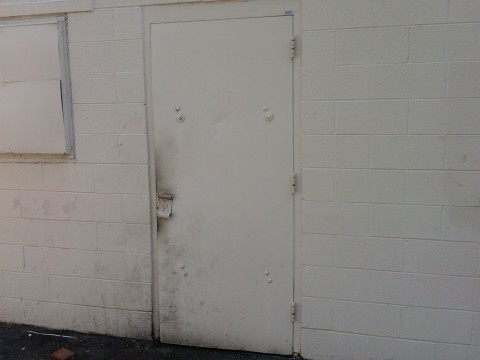
Flip Fierro from City of Raleigh (NC) Ladder 1 sent in a door he found that proves a very valuable forcible entry lesson. Forcing the door may be much simpler than you think. At first glance this door appears that it has two drop bars installed, as indicated by the carriage bolt heads. But as you can see from the photo below, the supplemental drop bar has been removed.

If you look close the photo below you can even see that the door has a significant bow in it where the drop bars used to be in place. This should be a good clue that the door needs to be further evaluated prior to selecting a forcible entry technique. Simply “gapping” the door with the irons (near the suspected supplemental lock) would verify whether or not the bars are installed. It would only take a second. Valuable time could certainly be lost trying to defeat a supplemental lock that in not in service.


We use a steel rod that has been bent in a modified ‘L’ shape. Punching a quick hole just below the level of the door handle, towards the middle (using a pick head or haligan) gives you enough of an access point to push the steel rod through. The modified L allows you to manipulate it to the point that you can use it to push the panic hardware, opening the door. The entire process takes less than 30 seconds. I will try to send pictures of the steel…
Hey Chad, make us a video…
Many Commercial Occupancy FE examples here on this site. One thing I always tried to do with my new guys and students was incorporate another piece of the puzzle of what is going on while this door is being forced. As Chad mentioned above “it takes 30 seconds.” Well, from experience that is good and bad. Good, because we wont burn a lot of energy and time on getting her opened up. Bad, becasue of the Backdrafting possibility. Timing is everything. Venting for fire in a taxpayer or commercial occupancy requires some patience and allowing the vertical (roof) opening to get going and let all that shyte go up and away. For those takign thigns from heere and passing them on, draw the picture thier heads as to what else is going on at the incident.
Stay Safe.
Make a video? Geez. I am doing good to get the email sent on the first try. I can’t even find where to send the picture of the tool!!!
Chad, sounds like a variation of the “carpenter’s square” method.
The same yet different.
😉
man when its two oclock in the moring and its dark and all how am i going to know that this door is in front of me. i am going to cut the dog crap out of it. second what is this thing you can a taxpayer?
Taxpayer:
The definition varies a bit, depending on where you are from.
In my neighbourhood it’s generally a commercial building with apartments over top.
The rent fromt he apartments helps with the taxes associated with owning a building/business.
In other cities it may be just a cheaply contructed building that was thrown up on the cheap so that when it was rented the $ could pay the land tax for the land/property owner.
I believe that videos of what Chad was describing can be found here:
http://www.fireengineering.com/index/articles/display/5082213097/articles/fire-engineering/truck/2011/03/hittle-tools.html?=new
One of the videos even shows the firefighter poking a hole with the haligan as was described by Chad.
Yes, ef, great find on those videos. That is exactly what I was referring to. Especially the fourth video. A quick hole made by a pick head gives you all the access you need.
I like the J-tool idea more for non-emergent alarms and well-being checks. For fires, I think it’s def something to have in the ol’ noggin’ and practical for most of the doors in the videos (where you’re pretty certain of the locks you’re up against), but I’d tend to go with the irons. For the door mentioned in Jimm’s post, you’re not gonna know if the drop bars are in place or not until after you’ve tried to force it. With the irons, you’re already one step ahead over the J-tool if the bars are in. If they’re not, the irons will get this door just as quick. Still a good link with the article and vids, though.
I would agree with Nate999 that conventional FE with the irons is the best way to go, for fires obviously. Most likely, during the process of gapping this door the slam latch on the mortise lock will fail. If you get through and feel resistance, then your going to know your drop bars are in place. If thats the case, I would then attack the carrage bolts by driving them through using the pike to make a hole then the adz to drive them the rest of the way. Maybe a little extra work but there is no need to carry the framing square or a modified piece of metal. If you have to resort to driving through the door to activate the panic hardware on the other side, drive the pike through, then the adz to gap and open it up a bit, then push the fork end through and use your probar to activate the panic hardware.
Sorry for the long rant, just my thoughts.